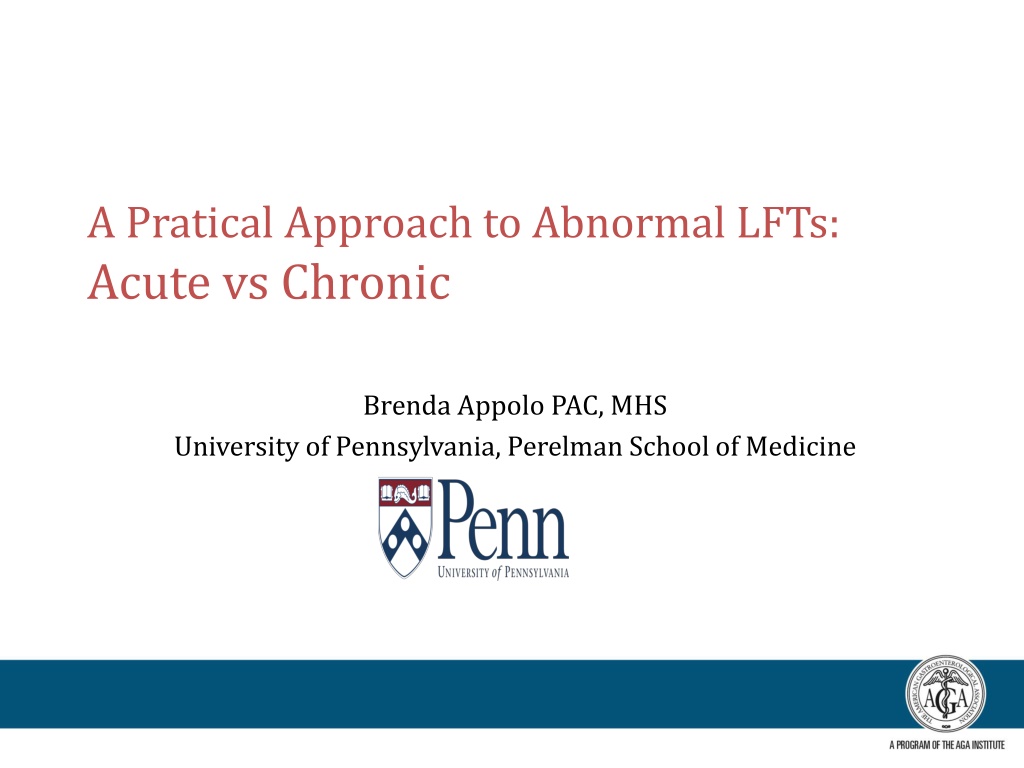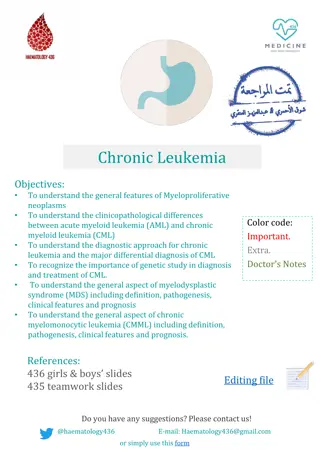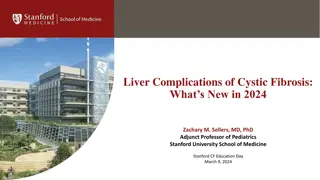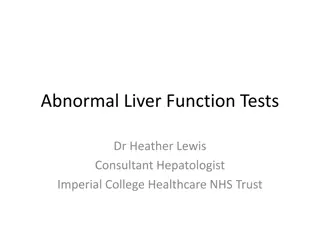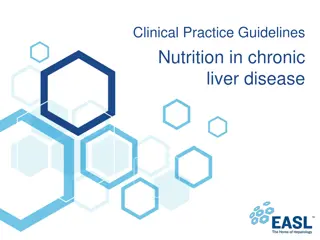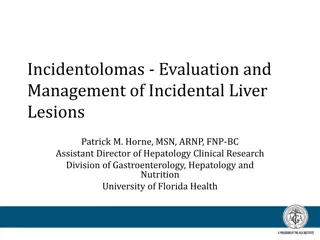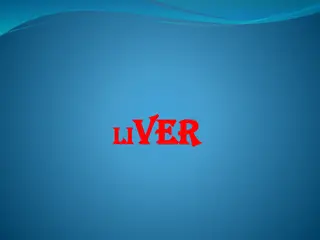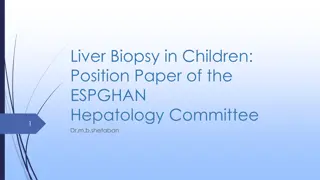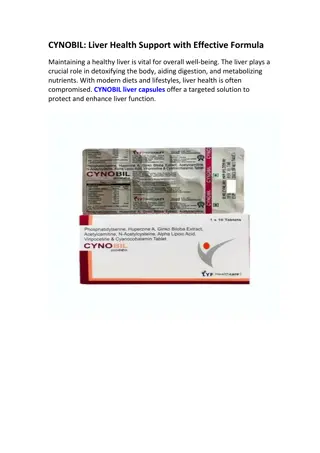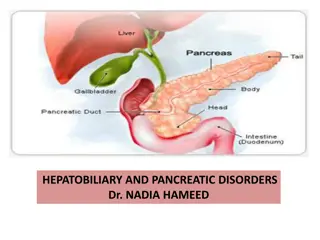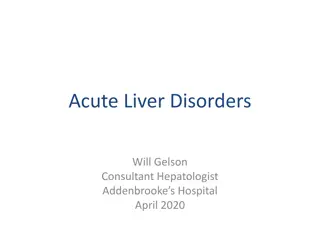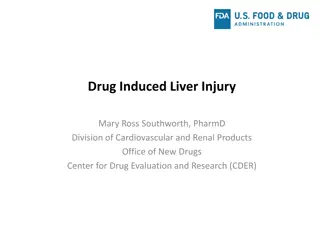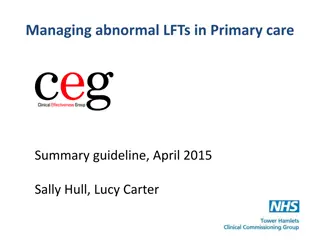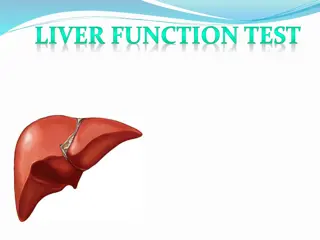Understanding Abnormal Liver Function Tests: Acute vs. Chronic Approach
Comprehensive discussion on assessing patients with abnormal liver test results, focusing on distinguishing between acute and chronic liver conditions. Covers diagnostic workup, patient cases, and differential diagnosis, emphasizing the importance of patient history, physical examination, and key diagnostic tests. Includes insights on acute liver failure, acute-on-chronic liver failure, acute and chronic hepatitis, and recommended approaches to managing liver patients.
Download Presentation

Please find below an Image/Link to download the presentation.
The content on the website is provided AS IS for your information and personal use only. It may not be sold, licensed, or shared on other websites without obtaining consent from the author. Download presentation by click this link. If you encounter any issues during the download, it is possible that the publisher has removed the file from their server.
E N D
Presentation Transcript
A Pratical Approach to Abnormal LFTs: Acute vs Chronic Brenda Appolo PAC, MHS University of Pennsylvania, Perelman School of Medicine
Objectives Discuss history, physical and diagnostic work up of patients with acute and chronic liver test abnormalities Discussion of patient cases and practical ddx
Approach to the Liver Patient Acute vs Chronic Acute Liver Failiure (ALF) - Accepted definition: INR > 1.5 and any degree of mental alteration (HE) in a patient without pre existing cirrhosis - illness up to 26 weeks duration -Most common: Viral, Drug -Patients w/ Wilson Disease, vertically acquired HBV or AIH may be included in spite of possibility of cirrhosis if their disease has only been recognized for 26 weeks or less Acute on Chronic Liver Failure -Acute-on-chronic liver failure (ACLF) is an increasingly recognized entity encompassing an acute deterioration of liver function in patients with cirrhosis, which is usually associated with a precipitating event leading to liver or multi organ failure
Approach to the Liver Patient Acute vs Chronic Acute Hepatitis -Time limited injury to the liver -Often does not lead to hepatic fibrosis -Not a diagnosis rendered on liver biopsy alone -Viral most common HAV, HBV, EBV, HSV Chronic Hepatitis -Inflammatory state with propensity to cause liver fibrosis -Histological hallmark includes influx of chronic inflammatory cells, lymphocytes and plasma cells - LFT elevations for > 6 months -Chronic hepatitis does NOT denote a specific etiology Chronic hepatitis does not always signify chronic liver / intrinsic disease! (i.e.: celiac disease is a reactive hepatopathy)
Approach to the Patient History is paramount Sx onset; many patients asx though Sx anorexia, weight change, fever, malaise, GI sx, rash, pruritus, lymphadenopathy Family History Medications / Herbal therapies Social History blood transfusions; IVDU; intranasal drugs; anabolic steroids; tattoos; incarceration, EtOH, travel, occupational exposures
Approach to the patient Physical Examination Nutritional Status Proximal muscle wasting Neuro Psych Asterixis; Mini mental exam (serial 7s) Scleral icterus Detectable typically if t bili > 3.0 mg/dL Skin Ecchymosis; Petechia; Spider angiomata; Jaundice Abdominal Exam Abdominal bruits; Caput Medusa Hepatomegaly; Hepatic mass Pulsatile Liver (tricuspid regurgitation) Ascites (fluid wave; shifting dullness; tense abdomen) RUQ pain Splenomegaly
Approach to the patient Laboratory Testing Liver Function Tests (cholestasis / transaminitis / mix) AST; AST; Alkaline Phosphatase Total bilirubin direct / indirect GGT Albumin CBC Platelets; H/H; MCV; WBC PT / INR Basic Metabolic Panel Serum Sodium Potassium Creatinine / BUN
Approach to the patient Laboratory Testing Viral serologies HAV; HBV; HCV; EBV Iron panel Total iron, Ferriten, T Sat, Transferriten Autoimmune panel Anti-LKM Ab, ASMA Ceruloplasmin Serum Copper A1 Antitrypsin AMA ANA Quantitative Immunoglobulins IgM, IgG, IgA
Approach to Liver Patient ALF Initial Laboratory Assessment Prothrombin time/INR Chemistries sodium, potassium, chloride, bicarbonate, calcium, magnesium, phosphate glucose AST, ALT, alkaline phosphatase, GGT, total bilirubin, albumin creatinine, blood urea nitrogen Acetaminophen level Toxicology screen Viral hepatitis serologies anti-HAV IgM, HBSAg, anti-HBc IgM, anti- HEV , anti-HCV* Ceruloplasmin Level / Copper * Autoimmune markers ANA, ASMA, Immunoglobulin levels Arterial blood gas Arterial lactate Complete blood count Blood type and screen Pregnancy test (females) Ammonia (arterial if possible) HIV status (if txp potential) Amylase and lipase *Done only if Wilson disease is a consideration e.g., in patients less than 40years without another obvious explanation for ALF); in this case uric acid level and bilirubin to alkaline phosphatase ratio may be helpful as well.
2Q== 2Q== Approach to patient: staging injury Percutaneous Needle Liver Biopsy Transjugular Liver Biopsy (TJLB / portal pressures) Noninvansive Markers Fibroscan MR Elastography ANd9GcRGwkelXfas7XLhCkL5hmCZykb6UDPm4qEypjQRwUq5XDcfv-7W_A ANd9GcTXTs8wb7tOM8lVuNPfdJ69H3B0OU_7kvmV1xwOAV6ru0JNJ0sm ANd9GcQs1vtsfA8SN6YcHzWhjxjIROaPUka0rllDCcCEGFDdst7Do9H5 ANd9GcT7jqs7bt6DeLolZP-HtmcEwMcsfIYxaPO88r5H7RMY9IjYjyXreA
Liver Diseases: Overview - DDx Viral HAV HBV HCV Other EBV, CMV, HSV Steatohepatitis (Fatty Liver) Alcohol Non alcohol (metabolic syndrome) Pregnancy (microvesicular fatty droplet formation) Drug Autoimmune Hepatitis
Liver Diseases: Overview - DDx Metabolic Wilson s Disease copper overload Alpha 1 Antitrypsin Disease Hereditary Hemochromatosis iron overload Drug Toxicity Antibiotics Statins Herbal / Other Vascular injury Veno-occlusive Disease Budd Chiari Syndrome Congenital Congenital Hepatic Fibrosis Polycystic Liver Disease Caroli s Disease Alagille s Syndrome
Case #1 18 male presents with general malaise x 2 m, 10lb weight loss to his primary care office Student health records 6 m prior with normal LFTs AST 901; ALT 848; AlkPhos 343; T bil 5.4; WBC 8.6; Hg 14.7; MCV 92; Plt 201; INR 1.2 U/s Abd: borderline hepato-splenomegaly; otherwise normal appearing liver; normal gb Does this patient have acute liver failure or acute hepatitis? What is your differential diagnosis? What other information is helpful to you at this point? Should we do a liver biopsy? Does this patient have portal hypertension?
Case #2 59 black male presents for yearly check up to primary care Primary care opts to start a statin for hyperlipidemia; obtains pre treatment labs No other sig PMHx FHx CAD, DM, Hyperlipidemia SHx alcohol rare; never smoker; no illicit drug hx ; no transfusions AST 64; ALT 84 ; AlkPhos 200; T bil 1.3; Albumin 3.2 WBC 6.2; Hg 16.7; MCV 98; Plt 117K RUQ (limited) U/s Abd: Increased echogenicity of liver, no obvious cirrhosis; no liver mass; no ascites; top normal spleen What is your differential diagnosis? What other information is helpful to you at this point? Do you want a liver biopsy? Is a statin contradindicated?
Case #3 67 yr old female presents with malaise, jaundice to primary care PMHx hypothyroidism T bil 6.5; AST 590; ALT 463; Alb 3.4; AlkPhos 300 WBC 6.5; Hg 12.3; MCV 91; Plt 215k Cr 1.2; INR 1.3; AFP 3 What is your differential diagnosis? What other information are helpful to you at this point?
Case #4 53 F presents to GI office post hospitalization for jaundice, ascites and abdominal pain Discharge labs: Cr 1.4; Na 131; K 3.3; T bil 8.5; AST 75; ALT 32; AP 212; Alb 2.6; Hg 9.4; WBC 13; Plt 90k; MCV 103; Fluid analysis 314 PMN; culture negative; high SAAG U/s Abd: hepatomegaly; mass can not be rule out based on limited exam; distended gallbladder; no acute cholecystitis; moderate ascites; enlarged spleen; PV patent What is your differential diagnosis? What other information are helpful to you at this point? Surgery consult?
